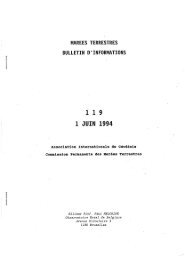marees terrestres bulletin d'informations - Université de la Polynésie ...
marees terrestres bulletin d'informations - Université de la Polynésie ...
marees terrestres bulletin d'informations - Université de la Polynésie ...
Create successful ePaper yourself
Turn your PDF publications into a flip-book with our unique Google optimized e-Paper software.
The instrumentation of the tidal station has improved significantly thanks to the<br />
superconducting gravimeter (SG) OSG-050, installed in February 2007. The Pecný station as the<br />
core station of ECGN (European Combined Geo<strong>de</strong>tic Network) is equipped with permanent GNSS<br />
station, absolute gravimeter (AG) FG5#215 and the superconducting gravimeter OSG-050. These<br />
high quality instrumentations in the field of gravimetry allow to monitor wi<strong>de</strong> range of gravity<br />
variations of geophysical origin from Earth’s free oscil<strong>la</strong>tions to secu<strong>la</strong>r gravity variations.<br />
Possibility of frequent simultaneous AG and SG observations at the station allow to solve main<br />
problems of both instruments: drift and calibration of the OSG-050 and the offset variations of the<br />
FG5#215.<br />
2. Calibration and drift<br />
The calibration factor and drift of the SG has been <strong>de</strong>termined using simultaneous<br />
observations with the AG (Hin<strong>de</strong>rer et al. 1998). Altogether 15, typically one-day absolute<br />
measurements with FG5#215 has been carried out from April 2007 to June 2008. For the purpose of<br />
SG calibration, five AG campaigns has been exten<strong>de</strong>d to three-days observations. These exten<strong>de</strong>d<br />
observations were carried out during tidal variations at least 230 Gal. The precision of all<br />
individual <strong>de</strong>termination of scale factor was better than 0.07%. However, the final calibration factor<br />
and corresponding accuracy should be computed from results of repeated calibrations. The<br />
dispersion of individual results with corresponding error bars in Fig. 2 show necessity of such<br />
repeated measurements. The final calibration factor of the OSG-050 has been <strong>de</strong>termined as average<br />
of all calibrations . From dispersion of individual result we can assume that accuracy of the final<br />
calibration factor is of about 0.06%.<br />
Fig. 2. Calibration factor of the OSG-050 <strong>de</strong>termined from 5 simultaneous three-days observations with<br />
FG5#215. Error bars represents precision of individual calibrations.<br />
The SG drift has been <strong>de</strong>termined from the comparison between SG and AG observations<br />
(see, Fig. 3 and Fig. 4) and <strong>de</strong>scribed by linear term 1.7 0.4 Gal/year. We can assume, that after<br />
removing drift from SG time-series, the rest of differences between AG and SG is caused mainly by<br />
random and systematic errors of the AG. This approach can help to <strong>de</strong>tect variations in AG offsets.<br />
In our case (see, Fig. 4) all differences are within expected error bars of the AG (1.1 Gal, Niebauer<br />
et al. 1995). Comparison of both techniques has been used for the evaluation of FG5#215<br />
repeatability (precision) by such experimental way. The standard <strong>de</strong>viation of individual absolute<br />
gravity measurements of 0.6 Gal respect to the OSG-50 observations <strong>de</strong>scribe the precision of the<br />
FG5#215. It is necessary to say that the FG5#215 is not installed permanently at the Pecný station<br />
and the precision of 0.6 Gal inclu<strong>de</strong>s error of instrumental set-up, meter alignments etc.<br />
11820



